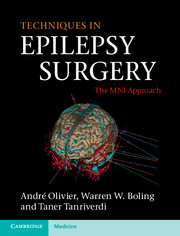Book contents
- Frontmatter
- Contents
- Acknowledgment
- Preface
- 1 History of epilepsy surgery
- 2 The search for the epileptic focus: investigation of the surgical candidate
- 3 Surgical anatomy
- 4 Neuronavigation and preoperative brain mapping
- 5 Stereoelectroencephalography (stereotactic intracranial recording)
- 6 Anesthesia and awake procedure
- 7 Peroperative brain mapping
- 8 Endopial resection (intervascular endopial gyral emptying)
- 9 Surgery of temporal lobe epilepsy: cortico-amygdalohippocampectomy
- 10 Surgery of temporal lobe epilepsy: transcortical selective amygdalohippocampectomy
- 11 Surgery of central area epilepsy
- 12 Surgery of frontal lobe epilepsy
- 13 Surgery of parietal lobe epilepsy
- 14 Surgery of insular lobe epilepsy
- 15 Surgery of occipital lobe epilepsy
- 16 Hemispherectomy
- 17 Callosotomy
- 18 Epilepsy and brain tumors
- 19 Surgical treatment of cortical dysplasias
- 20 Reoperations in failed epilepsy surgery
- 21 Alternative procedures in surgery for epilepsy
- 22 Complications of epilepsy surgery
- 23 Quality of life after epilepsy surgery
- Index
- References
16 - Hemispherectomy
Published online by Cambridge University Press: 05 October 2012
- Frontmatter
- Contents
- Acknowledgment
- Preface
- 1 History of epilepsy surgery
- 2 The search for the epileptic focus: investigation of the surgical candidate
- 3 Surgical anatomy
- 4 Neuronavigation and preoperative brain mapping
- 5 Stereoelectroencephalography (stereotactic intracranial recording)
- 6 Anesthesia and awake procedure
- 7 Peroperative brain mapping
- 8 Endopial resection (intervascular endopial gyral emptying)
- 9 Surgery of temporal lobe epilepsy: cortico-amygdalohippocampectomy
- 10 Surgery of temporal lobe epilepsy: transcortical selective amygdalohippocampectomy
- 11 Surgery of central area epilepsy
- 12 Surgery of frontal lobe epilepsy
- 13 Surgery of parietal lobe epilepsy
- 14 Surgery of insular lobe epilepsy
- 15 Surgery of occipital lobe epilepsy
- 16 Hemispherectomy
- 17 Callosotomy
- 18 Epilepsy and brain tumors
- 19 Surgical treatment of cortical dysplasias
- 20 Reoperations in failed epilepsy surgery
- 21 Alternative procedures in surgery for epilepsy
- 22 Complications of epilepsy surgery
- 23 Quality of life after epilepsy surgery
- Index
- References
Summary
Introduction and historical perspective
Dandy first established the feasibility of performing a hemispherectomy in the treatment of infiltrating gliomas, an approach that was ultimately abandoned due to a high tumor recurrence rate. In 1938, McKenzie reported on the effect of hemispherectomy to treat intractable seizures in a patient with spastic hemiplegia. Krynauw in 1950 performed hemispherectomy in 12 patients with intractable epilepsy due to natal stroke with encouraging results. In 1953, McKissock reported 18 patients using a similar approach that was successful in lowering the seizure tendency. Over the following decades hemispherectomy proved to be very effective to control seizures in patients with severe seizure disorders and large epileptic lesions. However, an insidious neurologic deterioration became recognized in some patients due to repeated subarachnoid seepage of blood into the hemispherectomy cavity. This complication usually presented many years after a successful surgery, resulting in membrane formation and hydrocephalus leading to deterioration in cognitive function. Rasmussen termed the phenomenon superficial cerebral hemosiderosis (SCH), and reported its occurrence in 33% of patients operated at the MNI for complete hemispherectomy.
A number of strategies have subsequently been described for preventing the occurrence of SCH, such as to reduce the size of the hemispherectomy cavity, and techniques have been developed incorporating this concept. One approach required a duroplasty to close the hemispherectomy cavity with occlusion of the foramen of Monroe. Hemidecortication was found to be effective by sparing the white matter and minimizing ventricular disruption. Rasmussen proposed a strategy of subtotal hemispherectomy whereby at least three lobes of the hemisphere were removed. He found hemosiderosis and hydrocephalus in none of the patients that underwent subtotal hemispherectomy. However, 70% of 48 patients with functional hemispherectomy became seizure free or had only a rare seizure after surgery compared with 85% who underwent complete hemispherectomy. The subtotal hemispherectomy was effective in preventing SCH but with fewer seizure-free patients. To improve the impact on seizure tendency, Rasmussen altered the surgical technique by performing a subtotal hemispherectomy combined with a disconnection of the remaining segments of the hemisphere from the corpus callosum and brainstem.
- Type
- Chapter
- Information
- Techniques in Epilepsy SurgeryThe MNI Approach, pp. 195 - 200Publisher: Cambridge University PressPrint publication year: 2012



